Intel's Pentium M Desktop Part II: ASUS' Pentium M to Pentium 4 Socket Adapter
by Anand Lal Shimpi on March 24, 2005 1:31 PM EST- Posted in
- CPUs
Overclocked Performance
Thus far, the Pentium M's performance is improved in some areas, but still remains weak overall in multimedia content creation applications, workstation apps, and media encoding. The ASUS CT-479 adapter allows the Pentium M to have more memory bandwidth than it needs, so if removing that bottleneck doesn't send the Pentium M to the top of the charts, then there's only one solution to improve its performance - overclocking.
Overclocking on the ASUS P4P800-SE with the CT-479 adapter is a much more positive experience than on any of the 855GME motherboards simply because the platform is far more stable when overclocked. But remember, you can't adjust the CPU core voltage or multiplier, so your only overclocking options are through increasing the FSB.
The Pentium M 770 has a 16.0x default clock multiplier running at a 133MHz FSB; we bumped the FSB up to 160MHz and took the CPU up to 2.56GHz. The memory speed stayed at a 5:4 ratio, which put our memory bus running at DDR400 speeds. Everything else remained the same, so let's look at how performance improved.
Overclocked Workstation Performance
With the exception of a couple of SPECviewperf tests, the Pentium M running at 2.56GHz ends up being a pretty formidable contender in our workstation tests:
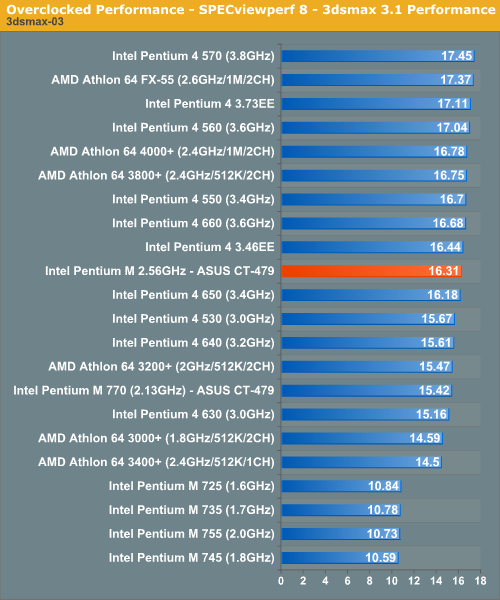
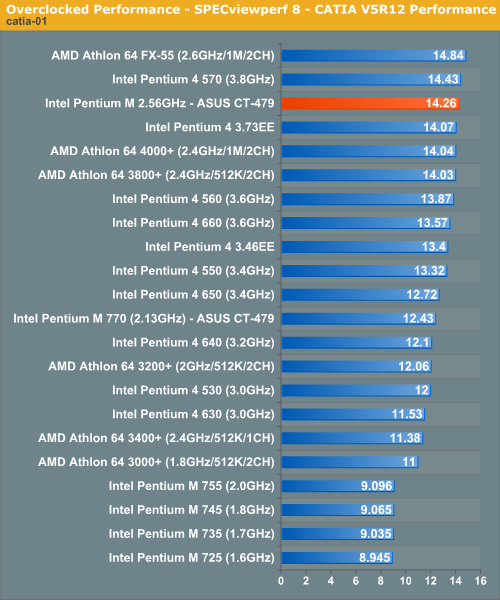
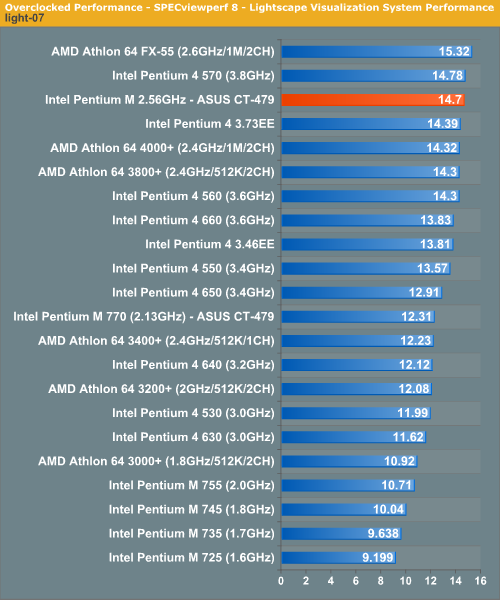
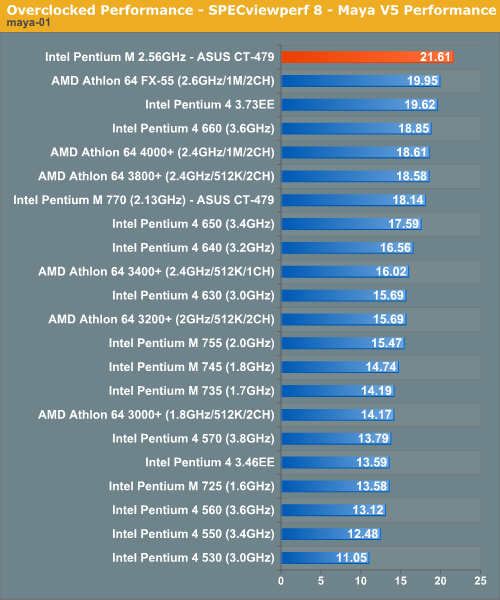
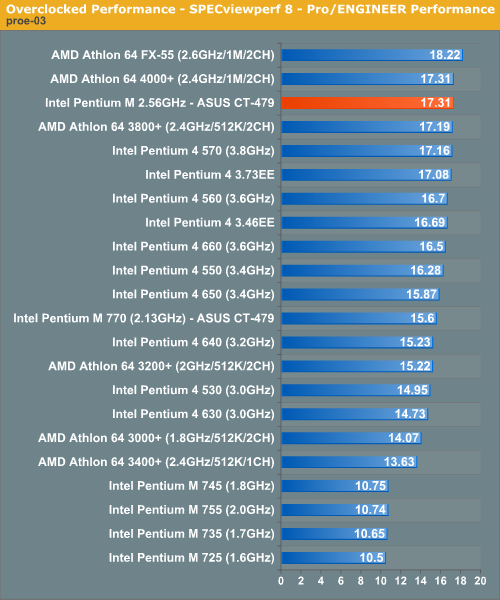

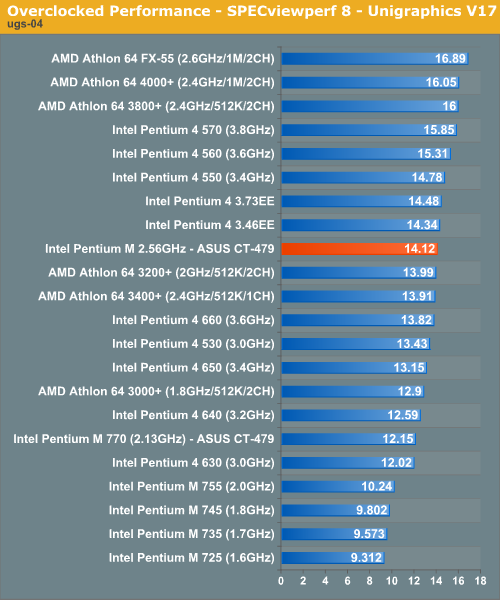
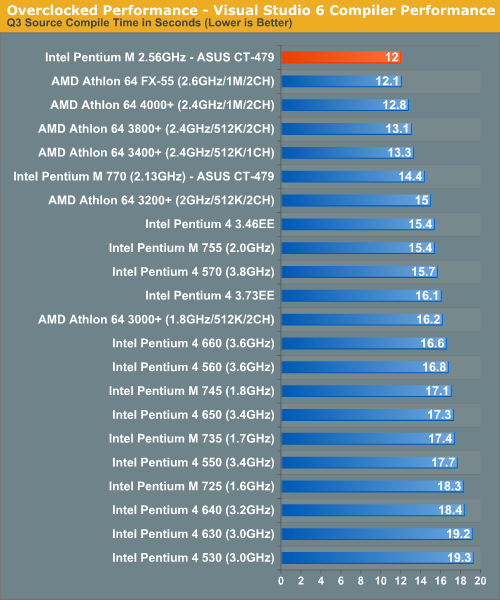










48 Comments
View All Comments
Houdani - Thursday, March 24, 2005 - link
With updates to floating point calculations and adding another core, Intel will need to think long and hard about putting their desktop chips into premature end-of-life in favor of going forward with the PM as their base product.Or, to summarize:
Blah blah blah nothing new that hasn't already been said before blah blah blather.
mlittl3 - Thursday, March 24, 2005 - link
Anand,You completely missed the point of the excellent data you obtained. Of course, this is just my point of view but here is my take on things.
The Pentium III stopped at 1.4 GHz. The Pentium picked up at 1.5 GHz (not including the low and ultra low voltage versions). We all know that the Pentium M is much more similar to the Pentium III than the Pentium IV. What if Intel never created the Pentium IV and continued improvements with the Pentium III? We would have had the Pentium M three to four years ago.
Intel screwed us all with its monopoly powers and sold high clock speeds to the masses with no thought about the performance of the Pentium IV. The last four years have shown us just that but no one complains or holds Intel accountable. As you have pointed out numerous times, the capital processor of the Pentium IV series, the Pentium IV EE is a complete waste of money.
In almost all of your benchmarks, the Pentium M shows almost the EXACT same performance as an Athlon 64 clock for clock. I say again, what if the Pentium M was developed at the time the Pentium III was discontinued? Intel and AMD would have matched clock speeds and we would have a Pentium M around 2.6 GHz right now with the similar performance of the Athlon 64 FX-55. The improvements you mentioned in the conclusion for Yonah (SSE and floating point) would probably already be implemented.
The Pentium M is THE processor from Intel. We had to wait four years for Intel's monopoly to be weakened but now we have a processor worth something. With multiple cores (each running at the speed of single cores since the Pentium M runs so cool) and all the other improvements from Yonah, that processor is going to be awesome.
Thank god for AMD challenging Intel with their terrific Athlon 64 architecture. Without them, computer processing would be in the dark ages. Guys, we need to stop supporting companies when they get to a certain size. The market needs to shift or we are going to get software like Windows and processors like the Pentium IV. With an even market share split between at least two companies, technology will excel past our wildest imaginations.
Okay, I will shut up now. I do want to add one thing. The ASUS adapter does nothing over the Aopen motherboard. If I am not mistaken, you compared a 533 MHz FSB, 133 MHz faster Dothan Pentium M to 400 MHz FSB, slower Dothans (I hope the other processors were Dothans and not Banias). The performance delta between the 770 and the 750 is exactly what you would expect from a faster clocked processor and a faster FSB. The 865 vs. the 855GME had nothing to do with the performance difference. The only advantage of the ASUS adapter is a cheaper overall cost of ownership.
bob661 - Thursday, March 24, 2005 - link
Oh yeah, if you're going Intel, this is the only CPU to own.bob661 - Thursday, March 24, 2005 - link
Intel really needs to lower the price of this CPU. A 765 is $645 on newegg. I can only imagine what the 770 would cost. If it was more price competitve, the P-M would be an excellent processor choice.rqle - Thursday, March 24, 2005 - link
i thought it did pretty well clock for clock on majority of the benchmark against the amd64 and did on par or so on gaming against the amd FX chips. Where it exceeds the PM it deal extremely well, and falls really shorts on things it didnt fair to well.Price wise for a "Desktop", i still believe AMD64 chip is the way to go. Great notebook chip that is not quite ready for the desktop area yet, need to improve its floating point performance and some desktop area. Did pretty well as gaming chip.
clarkey01 - Thursday, March 24, 2005 - link
Multitasking..lol...I mean, your going to get Intel fanboys saying " Its only has a 400 MHZ FSB" and what not. Well, why has it > ? its like saying the FX only has one meg cache, why doesnt it have two ?
clarkey01 - Thursday, March 24, 2005 - link
Mixed bag or what.Aileur - Thursday, March 24, 2005 - link
All in all seems like a middle of the pack solution. I thought the dual channel would give it a more significant boost but the pentium m seems to stay in the middle of the pack most of the time.I would still get it before i ever touched a prescott with a ten foot pole (and im an ex northwood user) but for the price theyre asking for dothans I dont see it being the desktop chip killer i was expecting.
I wonder though how Intel could clock this thing if it didnt have low power/heat in mind.